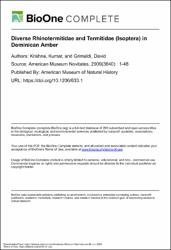| Abstract | The most diverse and best-preserved paleofauna of the higher termites heretofore known, all found in Miocene amber of the Dominican Republic, is described. The imago of Coptotermes priscus Emerson is redescribed, and the soldier of C. priscus, the first known fossil soldier of this genus, is described. The fauna includes the following 29 new species, all in existing genera, with Krishna and Grimaldi as authors of each: in the Rhinotermitidae, two new species based on imagoes of each—Coptotermes hirsutus and C. paleodominicanus; in the Termitidae, 23 new species based on imagoes—Amitermes lucidus, Anoplotermes bohio, A. cacique, A. carib, A. maboya, A. naboria, A. nitaino, A. quisqueya, A. taino, Atlantitermes antillea, A. caribea, A. magnoculus, Microcerotermes insulanus, M. setosus, Nasutitermes amplioculatus, N. incisus, N. magnocellus, N. medioculatus, N. pilosus, N. seminudus, Subulitermes hispaniola, S. insularis, and Termes primitivus; in the Nasutitermitinae four new species based on nasute soldiers—Caribitermes hispaniola, Nasutitermes rotundicephalus, Parvitermes longinasus, and Velocitermes bulbus. This brings the total termite fauna in Dominican amber to four families, 17 genera, and 39 species, a number that exceeds that of the present-day fauna of Hispaniola. Biogeographical, paleoecological, and phylogenetic implications of the Dominican amber termites are discussed. | es |


